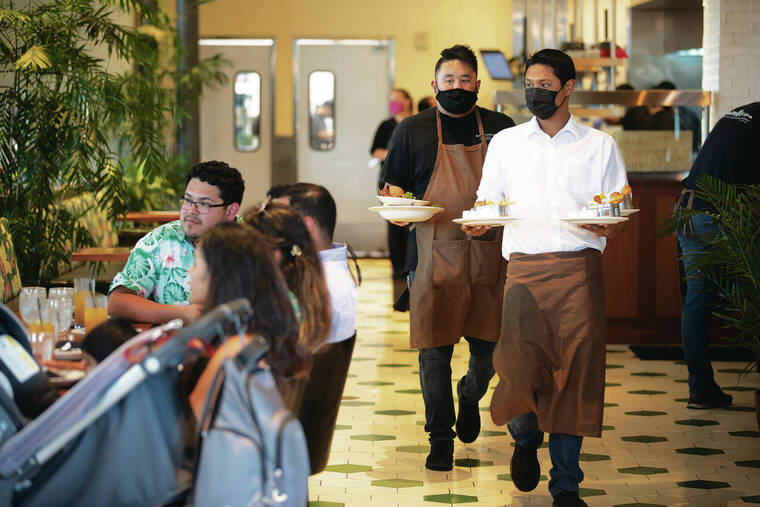To mask or not to mask?
As daily coronavirus cases in Hawaii and nationwide continue to trend down, the debate over mask mandates has become a hot-button issue, particularly in the Aloha State, the last holdout with a statewide indoor mask mandate in place and no announcements on when it will end.
Gov. David Ige is still in discussions with the state Department of Health over the indoor mask mandate, according to his office. An announcement is expected, however, before the state’s current COVID-19 emergency proclamation expires March 25.
Previously, Ige had issued a statement to the Honolulu Star-Advertiser saying he was working with the Health Department “to determine when the time is right” for the state to lift the indoor mask mandate.
The U.S. Centers for Disease Control and Prevention, meanwhile, loosened federal mask-wearing guidelines today.
The CDC reportedly plans to shift the metrics it uses in determining whether to recommend face coverings, from COVID-19 case counts to hospitalizations and hospital capacity, to reflect a “more holistic view of risk from the coronavirus to a community.”
Under the expected new guidelines and according to current data, the vast majority of Americans would no longer live in areas where indoor masking in public is recommended.
The CDC as of Thursday still recommended universal, indoor masking in schools Opens in a new tab as well as for people ages 2 and up not up to date with their COVID-19 vaccines in public indoors, and anyone in an area of substantial or high transmission. In general, people do not need to wear masks when outdoors, CDC said, but might consider it under certain circumstances.
On Thursday the Health Department reported eight more virus-related deaths and 289 new infections statewide, bringing the state’s totals since the start of the pandemic to 1,312 fatalities and 235,124 cases.
The seven-day average of new cases statewide was at 256 Thursday, a 68% drop from two weeks ago. Hawaii’s average positivity rate was at 3.4%.
The state listed 103 patients with COVID-19 in hospitals on Thursday, a 74.3% drop from a high of 401 during the omicron surge in late January. Of the 103, 10 were in intensive care, with five on ventilators.
Vaccination rates have continued to inch up, with 76.3% of the state’s population completing the primary series and 37.2% boosted.
The DOH supports the governor’s decision to keep the indoor mask mandate in place for now, according to spokesman Brooks Baehr, who pointed out that several U.S. counties and municipalities have also opted to keep theirs in place.
Nearly all U.S. states with indoor mask-wearing mandates during the omicron surge are letting them lapse as COVID-19 cases drop precipitously. But rules vary in different counties, and masking will still be required for some schools and medical facilities.
“Let’s not lose track of what we’ve accomplished as a state and as a people,” said Baehr, noting Hawaii has the second-lowest COVID death rate in the U.S. “It’s a testament to the people of Hawaii and the way they’ve responded to this pandemic and cared about one another. It’s a testament that we’ve been consistent with the mandate.”
While some states lifted their mask mandates over the summer, just before the delta surge hit, Hawaii did not.
A recent Big Q poll of Star-Advertiser readers found 74% supported keeping masking in place for indoors and schools, while 19% wanted to drop all mask mandates, 5% favored keeping the indoor mask mandate but making it voluntary for schools, and 2% wanted to drop the indoor mask policy but keep it for schools.
Dr. Ashish Jha, dean of Brown University’s School of Public Health, recently tweeted that people could think of public health restrictions like the weather — when there is a storm, then bring out tools like a big umbrella (or vaccines), wear a raincoat (or good masks) and wear rain boots (or avoid crowded indoor spaces).
But during big surges, collective action is needed, which often means mandates, he said.
Once lifted, Baehr said, the indoor mask mandate would be difficult to reinstate. “Things are headed in the right direction, and we’re delighted,” he said. “We just don’t want to take our eye off the ball.”
Tim Brown, an infectious disease modeler at the East-West Center in Manoa, said he personally is not ready to unmask indoors.
“Omicron is still extremely contagious,” Brown said. “It’s still present in the community, and I’m certainly in an older category where I have to be concerned even though I’m fully vaccinated. I have zero intention of moving away from masks.”
Brown said though positivity rates are trending down, the state should take a cautious approach in easing indoor masking requirements.
“If we drop the mask suddenly rather than gradually scaling it down,” he said, “then, fundamentally, a whole group of new people become eligible to contract the virus, and we could see a resurgence.”
Public schools are the last place where masks should be dropped, Brown said, given that students here are typically sitting in close proximity for six hours a day at only a 3-foot distance under current guidance, and many classrooms lack highly effective ventilation systems.
In workplaces, likewise, he said, masks can serve as an effective safeguard in settings where co-workers sit near one another.
If the mask mandate gets dropped, he said, the state Health Department should encourage people to still wear them in public places to lower their risks from the coronavirus.
Brown said face masks, particularly high-quality masks such as N95s, help curb the spread of the coronavirus — which the CDC has acknowledged is airborne — in two ways: by lowering the risk of spreading it to others and lowering the chance of contracting it from others.
“The risk is still there. And the more people that mask up, the lower the risk,” he said.
———
The Associated Press contributed to this report.

